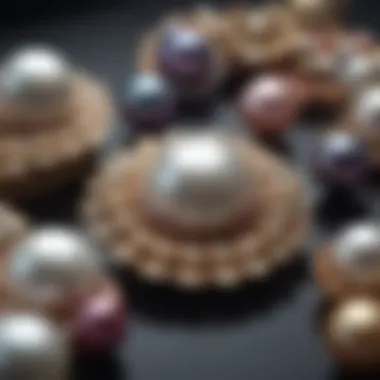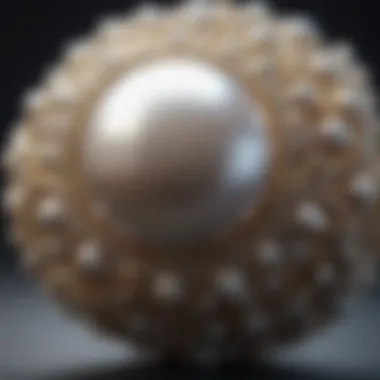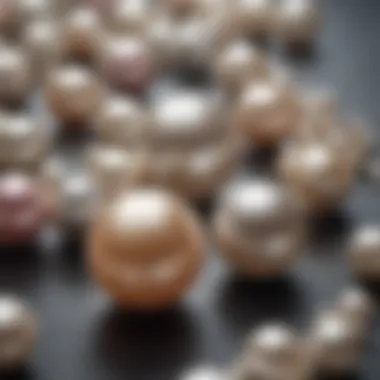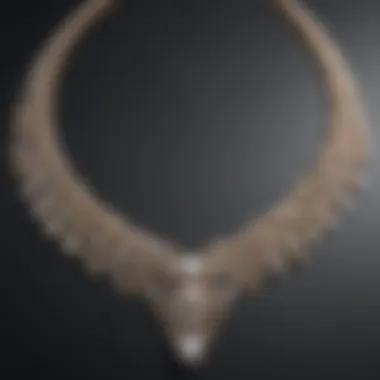Diverse Shapes of Pearls: Classification and Significance


Intro
Pearls have captivated the human imagination for centuries, often regarded as symbols of elegance and sophistication. Emerging from the depths of oceans and rivers, these organic gemstones manifest in a variety of shapes, each with its unique charm and story. Whether it's the classic round pearl or the more unconventional Baroque style, the diversity in pearl shapes influences not just their value, but also their use in jewelry design.
Exploring the world of pearls requires an appreciation of the nuanced processes by which they form. Cultured and natural pearls have their unique journeys that lead to the final product we see adorning elegant necklaces and stunning earrings. Diving deeper into the classifications and significance of pearl shapes reveals insights that resonate with collectors, jewelry designers, and gemstone enthusiasts alike. In this journey, we will highlight not only the physical properties of pearls but also their cultural implications and the craftsmanship behind their cultivation.
Understanding pearls isn’t just an academic exercise; it’s about connecting with a craft that has evolved over millennia. How pearls are perceived culturally and their evolving role in fashion and art illustrate the gemstone's importance beyond mere adornment. Let’s embark on this exploration of pearl diversity, touching on their marvelous shapes, formation processes, and the artistry that brings these gems from the sea to the jewelry box.
Foreword to Pearl Morphology
Understanding pearl morphology is like opening a treasure chest filled with nature's secrets. The diverse shapes of pearls reflect both their unique formation processes and the intricate biology behind them. Grasping the nuances of pearl shapes not only enhances one’s appreciation for these natural gems but also plays a significant role in jewelry making and valuation. Whether one is a collector eyeing the next addition to their assortment or a designer aiming to craft striking pieces, knowledge of pearl morphology is essential.
Understanding Pearl Anatomy
To really get into the nitty-gritty of pearls, one must first take a gander at their anatomy. A pearl essentially comprises three parts: the nucleus, the mantle tissue, and the shell. The nucleus is typically a foreign irritant, often a grain of sand or a piece of shell, around which the oyster secretes layers of nacre. This nacre is what gives pearls their famous luster and iridescence.
One important element to consider is the thickness and quality of the nacre. Thicker nacre often translates into better quality pearls, firing their lustrous glow to a higher brilliance. Various species of mollusks, such as oysters or mussels, produce pearls in different anatomical structures, leading to a wide variety of shapes and textures. Some pearls have a smooth finish while others showcase ripples, adding a unique touch to their aesthetics.
The Biology Behind Pearl Formation
Now, let’s dive into the biology aspect of pearls. How do they form? The process occurs naturally when a mollusk encounters an irritant in its environment. The creature’s defense mechanism kicks in, causing it to secrete nacre in layers around the irritant. This layering can be a meticulous affair, taking years to yield a fully formed pearl.
Factors such as water temperature, nutritional availability, and even the mollusk’s genetics heavily influence the pearl’s eventual shape. For instance, warmer waters may promote faster growth, resulting in different characteristics. Similarly, the health of the mollusk will also impact the final outcome, adding layers of complexity to pearl production.
When we bridge the gap between biology and morphology, we see how the conditions under which a pearl forms can lead to exceptional shapes. This interplay is part of the charm of pearls—no two are ever quite alike, and that is certainly something to dwell on for gem enthusiasts.
"Pearls are the unique creations of nature where biology and artistry meet."
In summary, understanding pearl morphology helps us appreciate not just their beauty, but the intricate processes and biology behind their formation. With this foundation, you are better prepared to explore the various classifications of pearl shapes that follow.
The Classification of Pearl Shapes
Understanding the various classifications of pearl shapes is key to appreciating their beauty and value. Each shape not only tells a tale of its formation and the environment from which it has emerged but also plays a significant role in how these gems are perceived in jewelry design and cultural significance. When jewelers and collectors consider a pearl, the first thing that often comes to mind is its shape. Shapes can dramatically influence the desirability and price of a pearl, which is why a detailed classification is crucial in the jewelry and gemological world.
Round Pearls
Round pearls are often considered the epitome of perfection when it comes to shape. Their symmetrical nature emits an air of refined elegance and has made them a classic choice for a variety of jewelry pieces. The term "round" does not merely refer to its circular appearance but implies an exceptionally smooth surface that can refract light beautifully.
The formation of round pearls typically occurs when the pearl oyster or mollusk experiences minimal stress and uniform growth conditions. Cultured round pearls, especially those produced in Akoya and South Sea oysters, tend to have higher valuations due to their rarity and the meticulous care taken during their cultivation.
- Market Value: Round pearls are often gold in the jewelry market due to their desirability.
- Usage in Jewelry: They can be found in necklaces, earrings, and bracelets, often becoming the centerpiece of any design.
Semi-Round Pearls
Semi-round pearls straddle the line between round and non-round varieties. They may exhibit slight imperfections or bulges, but still offer a pleasing aesthetic that appeals to many jewelry enthusiasts. These pearls can be a bit less expensive compared to perfectly round ones, thus attracting a broader audience looking for beauty at a more accessible price point.
A semi-round pearl's notable features are often highlighted in design, as they can add dimension and interest to pearl strands. For example, when combined with round pearls, they create a distinctive look that showcases the beauty of both.


- Design Flexibility: Their unique shapes allow for varied styles in fashion jewelry, making them versatile.
- Rarity Considerations: While less common than completely round pearls, semi-round varieties still hold a special place in the hearts of collectors.
Baroque Pearls
Baroque pearls are the free spirits of the pearl world. Their irregular shapes, which can range from strikingly unique to whimsically lumpy, defy conventional beauty standards. This irregularity results from an interference in the pearl's nacre deposition process, often due to environmental factors or the health of the mollusk.
Embracing the uniqueness of baroque pearls offers a remarkable opportunity for creativity in jewelry design. Each pearl tells its own story, making them particularly appealing to those who seek individuality in their adornments.
- Artistic Appeal: Jewelers often use baroque pearls to create transformative pieces that captivate the eye.
- Cultural Resonance: Many view baroque pearls as symbols of natural beauty beyond perfection, celebrating their flaws.
Drop Pearls
Drop pearls can be likened to teardrops of the sea. Their elongated shape makes them a popular choice for earrings and pendants, where they dangle gracefully. The sleek profile of drop pearls can add sophistication to any piece, while still providing a touch of whimsy.
These pearls are often featured in design where a sense of movement is desired, allowing light to catch their surfaces and enhance the visual appeal. The optimal choice for statement jewelry, drop pearls come in various sizes and color shades, lending to great versatility.
- Design Variance: From classic to contemporary, drop pearls can be styled to suit any aesthetic.
- Market Demand: Their popularity in recent trends helps keep demand high across various platforms.
Button Pearls
Button pearls are shaped more like a disc than a sphere. They often resemble the shape of a button, hence the name. This unique form allows button pearls to be set into jewelry in intriguing ways, providing a different visual effect than traditional round pearls.
Jewelers frequently use these pearls in earrings or as part of necklaces where they can lay flat against the skin, making them comfortable for everyday wear. Button pearls' flat surface can also create a striking contrast when used alongside round pearls in asymmetrical designs.
- Comfortable Wear: Their flatter shape gives them a snug fit in jewelry, making them suitable for long-term use.
- Craftsmanship Challenges: Creating button pearls often requires specific cultivation techniques, adding to their charm and value.
Overall, understanding the various pearl shapes enhances appreciation for their beauty and places them within the context of cultural and artistic expressions. As we explore deeper into the realms of pearl shapes, we're bound to uncover a treasure chest of insights on their market value and aesthetic roles in the world's jewelry collections.
Natural vs. Cultured Pearls
When delving into the world of pearls, the contrast between natural and cultured varieties emerges as a pivotal theme underpinning the entire industry. This distinction not only shapes market dynamics but also influences the aesthetic value and the allure of each pearl type. Understanding the nuanced differences is key for gemstone enthusiasts, collectors, and jewelry designers alike.
The Distinction in Shapes
The shapes of natural and cultured pearls can vary significantly, influenced by the processes involved in their creation. Natural pearls, formed spontaneously in the wild, often exhibit irregularities and unique shapes due to natural factors like the pearl oyster's movement and environmental conditions. They can be surprisingly diverse in form, creating a timeless appeal for collectors who appreciate the rarity of these organic gemstones.
Contrarily, cultured pearls, cultivated under controlled environments, tend to show more consistency in shape. While they can still present variations—such as the classic round shape or more unique baroque forms—culturing techniques often aim for uniformity to meet market demand. Consequently, this leads to a higher production of more desirable shapes, making them more accessible to consumers. The inherent value lies not only in the size and brilliance but also in the shape that often signifies the expertise of the cultivators.
Key Differences:
- Natural Pearls:
- Cultured Pearls:
- Irregular shapes and unique features.
- Formed without human intervention.
- Generally more uniform and predictable in shape.
- Created with human assistance, which can adjust cultivation conditions.
Influence of Cultivation Techniques


Cultured pearls owe their shapes to the specific techniques employed during their growth. Farmers introduce a nucleus into the mollusk, from which the pearl's layers build up over time. The nucleus can greatly affect the outcome. For instance, using a larger nucleus can lead to a substantial round pearl, while creating smaller nuclei may result in more varied shapes, like drop or baroque pearls. This molding by human hands allows for the design of pearls that appeal to various tastes and purposes in jewelry making.
The cultivation environment, including water quality, temperature, and the species of mollusk used, also plays a crucial role. Varieties like the Akoya, Tahitian, and South Sea each have methods that produce characteristic shapes. The growth angle, the surrounding water's currents, and even the location of the pearl farm contribute to how each pearl develops.
"Knowing the intricacies behind how pearls are shaped not only deepens appreciation for these gems, but it also informs better purchasing decisions for buyers seeking specific aesthetics."
Through the understanding of both natural and cultured pearls, enthusiasts can better contextualize their value and significance in the broader spectrum of jewelry design. The conversation around pearl shapes becomes more insightful, allowing for a richer appreciation of what goes into these exquisite creations.
How Pearl Shapes Affect Value
The shapes of pearls play a pivotal role in determining their market value, influencing buyer preferences and ultimately the price that collectors are willing to pay. The world of pearls is not just about the luster or color; the unique characteristics of their shapes often set them apart in a crowded market. Understanding how shapes translate into value can help enthusiasts and collectors enhance their purchasing decisions and investment strategies.
Market Preferences for Shapes
When it comes to the pearl market, buyer preferences fluctuate and evolve based on trends, cultural significance, and individual tastes.
Significantly, round pearls—often considered the hallmark of purity—tend to command the highest prices due to their rarity and universal appeal. A perfectly round pearl symbolizes traditional beauty and is often favored in classic pieces.
However, semi-round and baroque pearls are making waves, as buyers increasingly appreciate unique, irregular forms that resonate with personal expression. In recent years, the rise of artisan jewelry has encouraged a shift toward more eclectic shapes, appealing to those who value individuality over uniformity. This shift suggests that collectors are starting to see beauty in the unexpected, which can create a fascinating dynamic within the marketplace.
Some key points about market preferences include:
- Rarity: Unique shapes often attract more attention than perfect rounds, potentially leading to higher values if demand outstrips supply.
- Fashion Trends: Styles evolve; for example, drop and button pearls have been gaining traction in modern jewelry design.
- Cultural Influences: In some cultures, specific shapes hold particular meanings, persuading buyers toward those forms.
The Role of Rarity in Valuation
Rarity is a fundamental aspect of pearl valuation, especially when assessing pearl shapes. The more unusual and less common the shape, the more likely it is to fetch a higher price. As the saying goes, "What is scarce is cherished."
In the realm of baroque pearls, for instance, their irregular forms are celebrated for originality. The intriguing textures and distinctive designs make them sought after among collectors. Conversely, perfectly round pearls, although rare themselves, are often perceived as commodities in larger quantities, which can dilute their individual value.
Factors determining the role of rarity include:
- Supply Constraints: If certain shapes are less accessible due to environmental factors, the market often responds with elevated prices.
- Trend Cycles: Collectors may opt for shapes that reflect current fashion, impacting their market availability.
- Personal Attribution: Many jewelry designers and artisans place significant value on their innovative designs, spurring further demand for limited edition or uniquely shaped pieces.
"In pearls, as in life, uniqueness often drives desirability; those that hit the sweet spot of rarity and aesthetic appeal can shine brightest in the market."
The Aesthetic Appeal of Pearls
The aesthetic appeal of pearls is not merely a byproduct of their physical beauty, but rather a combination of their shape, luster, and the context in which they are set. Understanding this appeal involves looking closely at the subtleties that make pearls not just accessories but treasures in their own right. From the classic elegance of round pearls to the unique charm of baroque forms, each variety tells a story that resonates with both personal and cultural significance.
Design Considerations in Jewelry Making
When jewelry designers approach the task of incorporating pearls into their creations, they must consider a host of factors. The shape of the pearl plays a pivotal role in dictating the overall design. For instance, round pearls are often seen in classic stud earrings or pearl strands, showcasing their symmetrical and timeless quality. On the flip side, baroque pearls, with their irregular shapes, can be used to create bold statement pieces that attract attention.
- Proportion: The size of the pearl in relation to other design elements must be harmonious. A large drop pearl might look stunning as a pendant, but it may overpower smaller accompanying beads.
- Color Matching: Pearls come in a variety of colors ranging from white to black, pink, and gold. Designers must ensure that the color complements the outfit and the overall aesthetic they wish to convey.
- Setting Styles: Different shapes lend themselves to various types of settings. A button pearl may work well in a sleek, modern design while a drop pearl might suit more romantic or vintage styles.
- Texture and Surface Quality: A pearl's surface can vary from glossy to slightly textured. The interplay of light on these surfaces adds depth to the design and can enhance the overall visual appeal.
Pearls not only serve as focal points in jewelry but can also provide contrast and balance against other materials such as metals or gemstones, creating a striking dynamic.
Cultural and Historical Significance


The significance of pearls extends far beyond mere aesthetics; they have been symbols of status, wealth, and purity throughout history. Ancient civilizations revered pearls, viewing them as gifts from the gods. For instance, in ancient Rome and Greece, pearls were associated with the divine and were often worn by royalty. This connection between pearls and nobility continues to endure in various cultures today.
“Pearls have served as a currency of beauty, power, and culture, transcending borders and epochs.”
- In Asian Culture: Pearls are considered lucky and are often given as gifts during important life events, such as weddings. The Japanese have cultivated their own unique pearl jewelry traditions that reflect their deep cultural ties to the ocean.
- In Western Culture: The iconic lattice of pearls and wedding gowns reflects a tradition of purity, with brides often donning pearl jewelry on their special day.
- Symbolism in Art and Literature: Pearls appear in countless works of literature and art, often symbolizing wealth or unattainable beauty. They evoke imagery that enhances the narrative of romance and allure.
Today, the resurgence of interest in unique and vintage pearls reflects a growing appreciation for their history and versatility. Collectors and jewelers alike recognize that each shape holds its own narrative, connecting wearers to a rich tapestry of cultural traditions.
Care and Maintenance of Different Shapes
Taking care of pearls isn't just about aesthetics; it’s a matter of preserving the unique character of each shape. The value derived from a pearl is not purely from its inherent beauty but also hinges on how well it is maintained over time. Different shapes have varied characteristics, which means their care needs can differ too. Understanding how to maintain pearls appropriately is essential for anyone who values these oceanic gems, whether they are collectors, designers, or gemstone enthusiasts.
Proper care minimizes the risks of damage and keeps them in optimal condition for years to come. There’s a finesse in cleaning and storing pearls, as improper handling can lead to scratches, discoloration, or a dull appearance. Thus, recognizing the ideal methods for cleaning and storing distinct shapes becomes pivotal in the enjoyment and longevity of these precious jewels.
Cleaning Techniques for Various Shapes
Cleaning pearls requires a gentle touch and the right techniques, as they are softer than many other gemstones. Here are some tailored methods for maintaining the allure of different shapes:
- Round and Semi-Round Pearls: These shapes, being more common, are usually found in necklaces or bracelets. A soft, damp cloth is often enough to remove surface dirt. Make sure to do this after wearing, as perspiration can impact their shine.
- Baroque Pearls: Given their irregular shapes, they might retain more dirt in crevices. Use a slightly damp cloth, but avoid soaking them in water. Instead, consider using a gentle, natural soap solution in minimal amounts to wipe them clean.
- Drop and Button Pearls: While these shapes can withstand a little more rigorous cleaning if necessary, it is still advisable to err on the side of caution. With drop pearls, focus on the tapered end and clean with light, circular motions to avoid warping their unique form.
"Preserving the luster of pearls is akin to caring for a garden; gentle touches and attention are key."
When cleaning, never use harsh chemicals or abrasive materials. Always allow pearls to dry naturally after cleaning.
Storage Solutions for Pearl Jewelry
How you store your pearls impacts their condition, so smart storage solutions should be top of mind.
- Separate Spaces: One of the golden rules is to store pearls separately from other jewelry. Pearls can get scratched easily, especially by harder stones like diamonds or sapphires. Use a soft pouch or a dedicated compartment in your jewelry box to keep them safe and sound.
- Avoid Extreme Conditions: Keep pearls away from direct sunlight and away from moisture-heavy environments, as both can cause discoloration. Ideally, your storage space should be a cool, dry area to ensure their longevity.
- Breathable Containers: It’s crucial that pearls are able to “breathe.” As such, avoid plastic cases which can retain moisture. Instead, opt for a silk or natural fabric-lined box that lets the air circulate freely.
- Regular Inspection: Take the time to occasionally check on your pearls. Look for signs of wear, check the stringing on necklaces, and ensure they remain clean and lovely.
Caring for pearls isn’t merely about maintenance; it’s about preserving their story, their journey from the ocean depths to your collection. Each cleaning and storage decision influences their vitality, ensuring that they sparkle just as brightly in the future as they do today.
Culmination: The Significance of Pearl Shapes
Pearls, in all their varied forms, offer more than just beauty; they reflect unique environmental circumstances, human craftsmanship, and cultural significance. Understanding the implications of pearl shapes goes well beyond aesthetics—it's about appreciating a living history, the confluence of nature and nurture. Each shape tells a story, from its formation inside the mollusk to its journey into fine jewelry.
The significance of pearl shapes can be distilled into several key elements:
- Cultural Expression: Different shapes of pearls carry different meanings across cultures. For example, round pearls often symbolize purity and perfection, while baroque pearls can represent individuality and uniqueness.
- Jewelry Design: The particular shape of a pearl plays a crucial role in how it’s set in jewelry. Designers may choose specific shapes to elicit emotions or convey messages, adding depth to the finished product.
- Market Trends: Consumer preferences shift over time, impacting the desirability of particular shapes. Keeping an eye on these trends can provide insight into investment opportunities or collection strategies.
Considering these factors allows gem enthusiasts, collectors, and jewelry designers to develop a richer understanding of pearls. This awareness enhances appreciation not only for the aesthetic qualities of pearls but also their deeper significance.
Summary of Key Insights
As we unpacked the diverse shapes of pearls, several key insights emerged:
- Form Follows Function: The shape of a pearl often arises from the conditions of its formation. For instance, a round pearl generally forms in more stable conditions, while irregular shapes like baroque pearls arise from environmental stressors.
- Rarity and Value: The rarity of specific shapes can directly affect their market value. More unique forms tend to command higher prices due to the limited availability and the intrigue they bring to collectors.
- Versatile Applications: Pearls are not just for high-end jewelry. Their varied shapes allow for creative applications in fashion, interior decor, and even art.
Each insight contributes to a deeper understanding of pearls' diverse shapes, guiding enthusiasts in their appreciation of these natural wonders.
Future Trends in Pearl Shaping
Looking ahead, the future of pearl shaping is anything but stagnant. Here are some anticipated trends:
- Sustainable Practices: As awareness of environmental issues grows, sustainable methods of pearl farming will likely lead to new shapes and qualities, emphasizing ecological harmony in production.
- Customization and Personalization: Advances in technology enable more personalized approaches to pearl shaping. Customers may begin to demand specifically shaped pearls that resonate with their individual stories, preferences, or identities.
- Crossover with Technology: There’s a potential for a shockwave within the pearl industry as technology meets tradition. Innovations in biomimicry might lead to pearls that mimic new, yet-to-be-seen shapes, attracting fresh interest.







